
Embrace Nature's Whims with Tree Helicopters
Every spring, our neighborhoods become alive with curious flying seeds known as tree helicopters, or samaras, that descend like miniature rotors from the great heights of deciduous trees. While these whimsical flutters might elicit mixed feelings—from awe to annoyance—they embody a fascinating mechanism of nature designed for survival and growth. In this article, let’s explore the genetic ingenuity behind these airborne seeds and what they mean for homeowners and nature enthusiasts alike.
What Exactly Are Tree Helicopters?
Tree helicopters are essentially the winged seeds of specific tree varieties, chiefly the maple family. Officially termed samaras, they come in pairs and spin in a delicate spiral as they fall, an impressive aerodynamic design that allows them to float gracefully, extending their range far beyond that of other seeds which simply plummet to the earth.
But it’s not just maples that showcase this evolutionary marvel; trees like ash, elm, and sycamore also produce these fascinating seeds, each varying in shape and size. Their primary goal remains constant: to spread their genetic material effectively without the need for pollinators or animals. This mechanism allows them to traverse vast distances without being tethered to their parental roots, maximizing their chances of germination and growth in a new locale.
Stay Prepared: The Care and Maintenance of Your Yard
For homeowners, the arrival of tree helicopters means not only the beauty of nature but also a call to action. A surge in samara production can lead to clogged gutters, which may invite potential water damage if not monitored. It's crucial to check drainage systems regularly during peak seed dispersal seasons to prevent blockages that could lead to costly repairs. Additionally, it’s wise to explore the possibility of planting strategic trees in your yard that can enhance the ecological balance while also providing an aesthetic boost.
You Might Wonder, Why So Many Tree Helicopters This Year?
As you notice an abundance of tree helicopters, you might ask why certain years yield more than others. The answer lies in what arborists call "mast years," which occur when specific tree species release a significantly higher number of seeds. This survival strategy aims to overwhelm seed predators, increasing the likelihood of successful germination. Trees often respond to stressors like late frosts or drought by producing more seeds the following year, and observing this dynamic can help you better understand how your local ecosystem adapts to climate variability.
Future Trends: Understanding the Ecological Patterns
The proliferation of tree helicopters isn’t just a byproduct of local trees; it's also indicative of broader environmental trends. As climate variability continues to affect weather patterns globally, we may anticipate more extreme fluctuations in tree reproductive cycles. A substantial increase in samaras could signal underlying ecological shifts that ultimately affect local flora and fauna.
By being attentive to the signs in your garden—the ample spin of tree helicopters—homeowners can develop a deeper connection to their environment, understanding that their landscapes are not just aesthetic choices but integral parts of a larger ecosystem.
Experiencing Tree Helicopters: More Than Just Seed Dispersal
For many, the simple act of watching tree helicopters twirl down from the skies evokes a sense of joy and wonder. Kids delight in running through showers of these seeds, while adults can take time to embrace nature's artistry through activities like DIY projects that involve repurposing fallen seeds. Some might even use them in crafts for decoration or education, fostering a greater connection with the natural world.
Understanding the Bond between Trees and Homeowners
As a homeowner, understanding the cycle of tree helicopters equips you with knowledge that influences decisions regarding yard maintenance and landscaping. Whether you experience the delight or annoyance of these seeds, recognizing their purpose can enhance your perspective. It’s essential to appreciate not just the natural beauty they embody but the vital role they play in sustaining our environment.
Conclusion: Engage with Your Environment
Whether you’re a utilitarian homeowner seeking to maintain a pristine property, an environmental enthusiast, or a parent wanting to share the wonders of nature with your children, tree helicopters present an opportunity. Understanding their mechanisms not only enriches your gardening experience but empowers you to make informed choices for the landscape. Embrace the arrival of these natural wonders and connect deeper with your outdoor spaces.
Call to Action: Get involved with local gardening groups or community workshops as you explore ways to enhance your yard this upcoming season. Whether it’s learning about tree planting or engaging in fun activities revolving around nature, stepping into this journey allows you to witness firsthand the fascinating world of tree helicopters and more.
 Add Row
Add Row  Add
Add 




Write A Comment